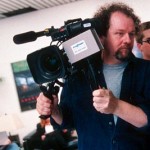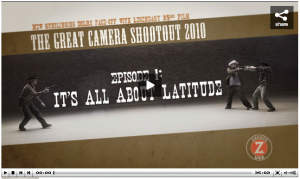We tested it out in a studio with some studio lighting, using just a kit lens, to see how it would fare compared to HD video cameras that we use everyday, like the Panasonic HVX-200. The results were very impressive, arguably besting what I’ve seen with the current generation of prosumer HD camcorders used by educational and event videographers and indie filmmakers.
The catch with the video dSLR is that you’re using a camera that wasn’t fundamentally designed for video. It’s an added bonus feature, if you will. So there are several limitations to work around: they only shoot about 12 minutes of video at a time, you can’t use the regular viewfinder, you have no autofocus or autoexposure, the rear LCD isn’t sharp enough to reliably get manual focus on its own. None of these is damning, and each can be worked around by a talented videographer willing to take her time and work carefully. Consequently, the dSLR is most appropriate for film-style production, especially dramatic productions, where sets are carefully lit, scenes are deliberately composed and the 12-minute take restriction imposed by the length of a film reel are ingrained and accepted elements of the workflow.
Video dSLRs are not yet ready to replace video camcorders, but they are an intriguing and comparatively low-cost option for filmmakers looking to exact very high quality images at a fraction of the cost of 35mm motion picture film.
Just how close dSLRs match the quality standard-bearer of film is subject to debate. So it was with great interest that I watched a recent “shootout” between several Canon and Nikon dSLRs and two grades of 35mm motion picture film that was staged by Chicago-based equipment rental house Zacuto. To be fair, it should be noted that Zacuto got into the video dSLR game early and now sells a line of accessories that allow cinematographers to better control and use their dSLRs. That said, I think the folks at Zacuto endeavored to make this a fair matchup by asking talented well-known cinematographers and DPs to participate in the shooting and evaluation. At thirty minutes the shootout video may seem long, but there’s little fat and it’s quite clearly explained even for relative newcomers to HD video.
Nearly all of the major digital camera manufacturers have added HD video to their cameras, both compact point-and-shoots and SLRs. The reason why dSLRs are particularly prized is because their large sensors more closely approximate (and sometimes exceed) the size of 35mm motion picture film, and because they have high-quality interchangeable lenses so that cinematographers can choose the one that best fits the application. Of particular interest is the ability to precisely control the focus point of the frame, choosing exactly what is in focus, and putting other elements out of focus.
This is difficult to achieve with compact digital cameras, and most consumer and prosumer camcorders which have relatively small sensors and fixed optics. These cameras have a relatively deep depth-of-field, which means more things are in focus most of the time. This is an advantage in many applications where it’s not practical to achieve fine manual focus, just as it’s a disadvantage when you want to precisely choose your focus.
This difference doesn’t mean that HD camcorders and compact digicams are inherently inferior. It just means that they are good for some purposes and less well suited to others. Today’s HD camcorders are still the best choice for event recording–from lectures to weddings–because they easily record one or more hours of continuous video to tape, memory cards or hard drives, without stopping every 12 minutes. They’re also great for documentary work because they are designed to be rugged, self-contained and, again, record more footage than a conventional film reel allows.
On the other hand, the video dSLRs give aspiring filmmakers as well as experienced cinematographers on a budget the ability to precisely control their image in way only possible with expensive 35mm film just a couple of years go. And, like miniDV, the ability to afford multiple cameras running simultaneously is likely to spark creative applications that would be prohibitively expensive with film.
Just one example of this bargain DIY creativity that really impresses me are some live concert videos shot in Chicago and Milwaukee by High Frequency Media. HFM uses two Canon 7D dSLRs, exploiting their shallow depth of field to create videos that are both modern and also reminiscent of classic concert films from the 60s and 70s.
Rabble Rabble – “Wild Card” – Live at The Empty Bottle from High Frequency Media on Vimeo.
I’m kind of curious to do a shoot utilizing a whole variety of modern video cameras–dSLRs, HD camcorders and even flip-style cams–to see what kind of imagination can be mined from juxtaposing their footage. Kind of like a bargain-basement Natural Born Killers approach. Let creativity bloom.




[…] See the article here: From miniDV to dSLR – Contemplating the New Era of Digital Video […]